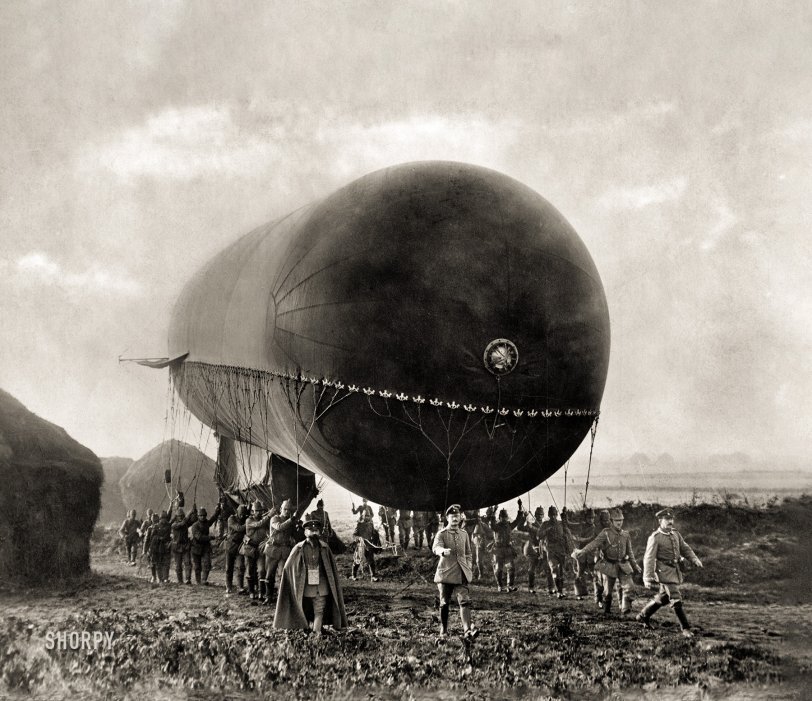


Framed or unframed, desk size to sofa size, printed by us in Arizona and Alabama since 2007. Explore now.
Shorpy is funded by you. Patreon contributors get an ad-free experience.
Learn more.

- Roll your own
- Rugged and real!
- A Charles Purcell - Mama Cass Connection
- Uncle SAAM
- Obfuscation
- One Chocolate Soldier rode away
- Victor Marquis de la Roche
- The Little House Across Way ...
- Vanderbilt Gates
- Vanderbilt Mansion
- You can still see that gate
- Withering heights for me
- So Jim,
- Top Heavy
- Re: Can't Place It.
- Bus ID
- Since you mention it
- The White Pages ?
- Moonlight Tower
- 1907?
- Fire(men) and Water
- Can't Place It
- Can anyone
- Wings
- Where's Claudette and Clark?
- Overbuilt Rolodex
- One song
- Give Me Wings Please!
- PRR
- Pinball Wizards
Printporium
Champagne Campaign: 1915

France circa 1915. "German tethered balloon being raised for observation purposes during the Champagne campaign (observation balloon being maneuvered through a field of haystacks by German soldiers in the Champagne region of France during World War I)." Gelatin silver print from the F.J.M. Rehse Archiv für Zeitgeschichte und Publizistik, München. View full size.
Not binoculars.
Looks more likely to be a map case.
Storm of Steel
An account of the First World War from the point of view of a young German officer, Ernst Junger, published in 1920. The appearance of observation balloons or airplanes from the other side was a bad sign, showing the enemy was well positioned, eager to move forward by getting a view of your communication and front trenches and rear lines, in preparation mode, and generally up to no good.
The officer on the left ...
In the cloak, appears to have a case hanging around his neck, likely holding a pair of binoculars. I think he is the observer who went up in this thing to see what he could see.
Casualty of war
Don't know how le boche fared, but my last Champagne campaign ended rather ingloriously.
Uniform observations
The soldier on the far right of the picture is an NCO. We can tell by the grey trim on his collar. This trim would also be on his shoulder tabs, with pips indicating his rank, but the picture isn't distinct enough to see them, but I would speculate that he is a "Feldwebel", or company sergeant major. In WWII they added several more ranks above Feldwebel, so in that war Feldwebel would just mean "sergeant". The soldier behind him has a marksmanship lanyard (Schützenschnur) attached to a button and leading up to his shoulder. The German army still uses them and in the 70's when I was stationed in Germany, US combat soldiers would often qualify for it and wear it on their dress uniforms. The two other soldiers in front are probably officers, with the one in the middle wearing his Iron Cross 2nd Class ribbon attached to a button. The soldiers aren't wearing the stereotypical "Pickelhaube" or spiked helmet. A cursory search seems to indicate they are wearing "Landsturm" shakos. The Landsturm was the third tier of soldiers after the Landwehr militia, usually older reservists. That's probably why they have been assigned behind the lines duties.
Just an addition: A picture of a soldier from Bavaria wearing the Landsturm shako on a death card that was usually handed out during funerals.
https://www.flickr.com/photos/drakegoodman/6773523334/in/photostream/
My translation of the card:
In pious contemplation in prayer for the honorable Sebastian Landesberger, groomsman from Velden am Vils, Unteroffizier (corporal) in the 2nd Reserve Infantry Regiment, 11th company, who died a hero's death at the age of 38 on 24th September 1917 in the hospital in St. Michel, France, due to his severe wounds.
You took leave of your beloved wife, never to be seen again! And we, the wife and children have had our hearts broken from the pain!
Heavy is the blow that has hit us, torn apart is the tender thread -- but one sweet comfort remains for us: you died as a hero for the Fatherland.
My Jesus, have mercy!
Special detachment?
The troops appear to be wearing blunter-than-usual Pickelhauben to prevent damage to the latest in military technology. The later Stahlhelmen will prove more practical for this detail.
























On Shorpy:
Today’s Top 5